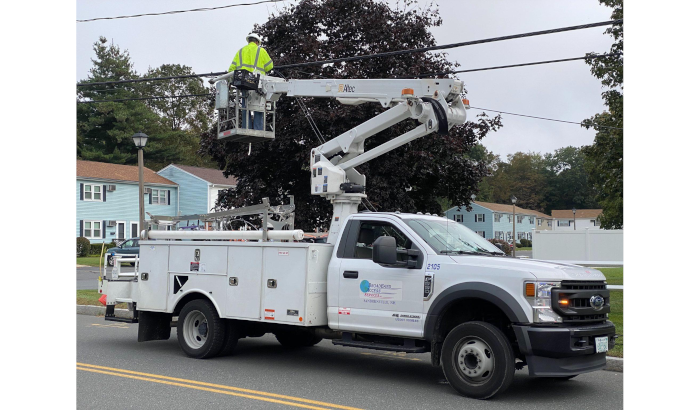
Addressing February’s Clean Harbors Chemical Fire
State’s response follows long history of environmental injustice around the Fore River Basin
On the evening of Feb. 16 earlier this year, a tractor trailer filled with paints, epoxies, oil filters, and other flammable liquids spontaneously ignited at Clean Harbors, the largest waste disposal site in New England. The fire spread quickly, fully enveloping two other trailers amidst a series of explosions and sending up a large plume of black smoke over the dense cluster of homes and industrial facilities that line the banks of the Fore River.
Located about 15 miles southeast of Boston where the town of Braintree intersects with Quincy and Weymouth at the Fore River, Clean Harbors is flanked by several other large industrial properties, which include a massive fuel storage facility, a natural gas plant, and a fertilizer plant. Across the river sits another large natural gas plant, another fuel storage facility, a chemical manufacturing facility, a recently-constructed high-pressure natural gas compressor station, and several residential neighborhoods.
Residents and community activists have long worried about a worst-case scenario in which a fire or explosion at one facility could trigger further explosions at neighboring sites in a deadly chain reaction. The Weymouth compressor, owned and operated by the Canadian pipeline company Enbridge, is designed to operate at a gas pressure up to 250 times higher than the system that triggered the deadly Merrimack Valley explosions in 2018, according to estimates from the nonprofit Greater Boston Physicians for Social Responsibility.

A deadly compressor explosion would not be unprecedented in the Fore River basin. In the spring of 1940, a compressor building in East Braintree exploded, killing four and injuring 12, while also destroying several buildings and igniting a fuel tank containing 750,000 gallons of illuminating oil.
With a bit of luck, history did not repeat itself in February of 2023. The Braintree Fire Department arrived quickly on the scene, but had to contend with multiple non-functioning fire hydrants at the site and limited knowledge of what was actually burning. More than three hours and about 400,000 gallons of water later, fire fighters from Braintree, Holbrook, Quincy, and Randolph finally controlled the blaze. Three of the eight trailers lined up in the loading dock were fully consumed, while one of the trailers spared by the fire contained thousands of gallons of waste fuel.
“I think the weather was on our side, it was a damp night,” Braintree Fire Chief James O’Brien said after the fire. “I think that moisture kind of tamped down the possibility of it spreading any farther.”
Since the explosions, residents have pushed Clean Harbors and the state to answer questions about the root cause of the fire, the lack of an emergency response plan coordinating between towns and industrial facilities, and the hazardous chemicals that nearby residents may have been exposed to by the fumes. At the time of the incineration, air quality monitors across the Fore River Basin showed dramatic spikes in air pollution.
Clean Harbors representatives, along with the Massachusetts Department of Environmental Protection (DEP), have largely downplayed the health impacts of this fire. According to the DEP, while the air pollution measured during the fire did exceed the regulatory limits, the standard practice is to average these spikes over 24 hours. When considered under this framework, the DEP has said that the air pollution did not exceed the national standards for short-term exposure.
But some residents and air quality experts are hesitant to cast aside concern.
“There was certainly a very significant spike in air pollution,” said Phillip Landrigan, the director of the Global Observatory on Pollution and Health at Boston College. “In adults, air pollution spikes can trigger heart attacks, they can trigger cardiac arrhythmias like atrial fibrillation, they can trigger cardiac deaths… and in children the principal risk is respiratory disease, especially asthma.”
A 2022 study authored by Landrigan and other Boston College researchers identified the impacts of air pollution in each town across Massachusetts. While the three towns that surround the Fore River—Weymouth, Quincy, and Braintree—all had annual air quality levels well within the federal regulatory standards, researchers estimated air pollution causes about 94 excess deaths across the three towns annually.
For many area residents, this fire is yet another chapter in a history of pollution exposure that has left them facing higher risks of health conditions including cancer and heart disease.
“There’s cancer everywhere on my street,” Braintree Town Councilor Elizabeth Maglio said. “You can point to the houses—I don’t think there’s a house that has escaped some sort of weird environmental cancer.”
“Until we all start growing an ear out of the side of our neck, nobody is really going to care,” Maglio said. “It’s been so difficult to get the attention of the state regulators who are the ones who have created this mess, and continue to greenlight all of these industries.”
Health surveys conducted in the area have shed light on elevated health risks faced by the surrounding communities. A 2002 study of Weymouth residents, conducted by the Weymouth Board of Health, found abnormally high levels of aplastic anemia, a rare bone marrow disorder that has been linked to exposure to benzene, an air pollutant emitted in the combustion of coal and oil, and frequently found in natural gas.
In 2017, facing pressure from residents about the potential health impacts of Enbridge’s Weymouth compressor station—which is now located across the river from the Clean Harbors—the Baker Administration commissioned a health impact assessment for the compressor, which included an evaluation of the current health status of the community. Released in 2019, the background health analysis of the report showed elevated concentrations of multiple conditions linked to air pollution exposure including: high levels of heart attack and COPD hospital admissions in Braintree, Quincy, and Weymouth; heart disease in Weymouth and Braintree; lung and bronchus cancer in Weymouth and Quincy; and pediatric asthma and asthma hospital admissions in Weymouth.
Despite these findings, the report ultimately concluded that the added air pollution from the compressor station would not have any impact on the health of residents in the surrounding communities. This prompted intense criticism from outside groups including Fore River Residents Against the Compressor Station and Greater Boston Physicians for Social Responsibility, which argued that the report underestimated the cumulative impacts of air pollution and overlooked elevated health risks for vulnerable populations.
A state-commissioned external evaluation of the health assessment criticized the report for its limited scope and resources, and concluded that it underestimated the health effects of air pollution below the regulatory thresholds and did not conduct adequate outreach to nearby vulnerable communities. The state’s assessment also put minimal focus on how health risks could increase for the town residents living closest to the sources of pollution, and failed to quantify how communities of color or lower income could be exposed to greater pollution levels.

The industrial facilities of the Fore River basin are surrounded by several communities that have been designated as environmental justice populations by the state due to lower median incomes and higher percentages of non-white residents. The immediate basin area has a higher proportion of people living in poverty compared to the surrounding towns, and a higher percentage of people of color compared to the towns of Weymouth and Braintree.
The 2002 report from the Weymouth Board of Health found a strong relationship between income level and several health conditions associated with pollution. Lower-income residents faced higher rates of cancer, heart attacks, bronchitis, and childhood wheezing and asthma. Meanwhile, adolescents from households making less than $25,000 were found to be almost five times more likely to miss school because of asthma compared to those from households making over $50,000.
Despite these well-documented health burdens, residents have once again been told not to worry in the wake of the Clean Harbors fire.
“My conclusion would be that the emissions from this fire did not result in levels that would result in adverse health risks to the community,” one consultant hired by Clean Harbors told residents at a Braintree town meeting after the fire.
Amidst questions over air quality, Braintree town councilors pushed Clean Harbors executives to commit to increasing their air monitoring at the facility. When asked to answer yes or no on whether the company would voluntarily increase air monitoring as a measure of good faith to the community, Clean Harbors executives declined to give a definitive answer.
“We can continue to take that under advisement,” responded Rebecca Underwood, the president of Clean Harbors.
Neither Underwood nor a Clean Harbors senior vice president responded to multiple requests for comment for this article.
The assurances of Clean Harbors seemed to give little comfort to the community members attending the meeting, many of whom lined up in the public comment period to express their displeasure. The last resident to speak at the meeting was Michelle Maloney, a longtime Braintree resident and mother struggling with metastatic breast cancer.
“We need to address the fact that there is a cumulative effect of all of this, and we owe it not just to me, to my 12 year old, to my husband, to my mother, but to all of us,” Maloney said. “I’m horrified about what we have allowed to happen in this community that I grew up in. And this is our moment to meet with these organizations and these companies who are our neighbors and demand that they help us figure out the resources that we need to protect all of us.”
Subscribe to Jon’s New England Climate Dispatch, a newsletter about climate justice, policy, and social movements at newenglandclimate.substack.com
This article is syndicated by the MassWire news service of the Boston Institute for Nonprofit Journalism. If you want to see more reporting like this, make a contribution at givetobinj.org





